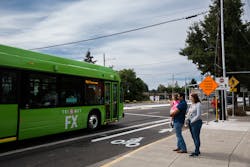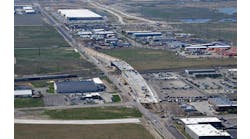By Kasey Delucia, Contributing Author
TriMet, the transit agency in Portland, Oregon, launched its long-awaited Frequent Express (FX) line along the city’s busy Division Street corridor last fall.
Known as Division FX, this high-capacity bus transit project is an example of how cutting-edge technology, infrastructure that’s planned for safety, and human-centered design can significantly improve the passenger experience. It also brings a myriad of benefits to what had been a busy and too often deadly street.
Located on one of the city’s highest ridership bus lines, Division FX combines safety, road improvement, bus rapid transit, cycling and pedestrian infrastructure, and neighborhood revitalization.
This transformative road project also leverages the most advanced signal priority technology available today to deliver better bus service to residents living in one of Portland’s most diverse—and historically, most dangerous—arterial corridors.
Division FX started as a transit project, designed to improve bus reliability. Southeast Division Street begins near the bike-ped-transit Tilikum Crossing Bridge over the Willamette River and runs east for 15 miles to the neighboring city of Gresham.
Division FX improves transit capacity and efficiency, with the signal technology priority aided by longer buses with room for 60% more riders, bus station platforms elevated for quicker boarding, multiple-door boarding, onboard bike storage and stations located where rider demand is greatest.
Completing a road project as big as this—focused on transportation planning and traffic engineering services for a future high-capacity transit service connecting important institutions like Portland State University, Portland Community College and Mount Hood Community College in Gresham—required cooperation from multiple local governments and transportation agencies in addition to TriMet and DKS Associates.
The Division corridor connects downtown Portland to Gresham, and the project is notable partly because it required so much cross-agency technology sharing. The transit agency TriMet linked its data to Portland’s networked central control, and the city of Gresham embraced installing new equipment that connected it to both systems.
For years prior to the implementation of this road project, Division Street was a two-lane street near the inner-city end that widened to a four (and then five lane) avenue further from the center of Portland. It has been a dangerous road for decades: along the eastern segment in particular, the percentage of crashes involving pedestrians was 50% higher than the citywide average.
The average distance between crosswalks was a quarter mile and crashes were 50% higher than the citywide average. About 40% of drivers using the road drove above the posted speed limit.
In addition to these critical safety issues, the city has been steadily growing over the years and on-time performance of buses along this busy corridor has steadily decreased.
As the project progressed over several years, it became clear that planning for high-capacity transit was not enough. The Division Transit Project expanded to include enhancing the fabric of the neighborhoods along miles of the road, in coordination with Portland Bureau of Transportation’s Outer Division Multi-Modal Safety Project, in order to dramatically reduce the number of injuries and deaths on the road and to vastly improve the experience for pedestrians and people riding bikes.
Infrastructure that does more
This entire project was built around a key design element: the infrastructure on the street had to be designed around people, not cars. Engineers designing the route prioritized pedestrians, people on bicycles and transit before cars.
That unveiled a need for more traffic signals (and signals that prioritized buses, bikes and pedestrians first), more safe pedestrian crossings, wider sidewalks, enhanced and protected bike facilities and lower posted vehicle speeds.
Even with the complexities of a corridor that included commercial businesses, houses and apartments, limited right of way and tens of thousands of cars each day, some creative solutions maintained mobility. Business Access Transit (BAT) lanes were employed to expedite transit service past vehicle congestion, while still providing access to local businesses and residents.
As the buses operate in mixed traffic for segments of the corridor, it was important to provide a careful balance of vehicle mobility to ensure transit speed and reliability, while also providing safer facilities for active transportation. This means points of conflict were greatly reduced along the corridor through the installation of raised center medians, with left turn vehicle access being provided through U-turns at traffic signals.
Because buses formerly stopped in the bike lanes, the Division FX resolved these conflicts through station designs that bring the bike up and over the platform with a delineated yield zone, or routes them behind the station in areas of higher ridership.
Next Gen TSP improves over time
Two significant components of Division FX that improved transit efficiency were the fiber optic network installed along the length of the corridor, and the design and implementation of a next generation transit signal priority system (Next Gen TSP).
The Next Gen TSP system—a key enabling technology and centerpiece of Division FX—accounts for some of the project’s biggest operational and service impacts. Next Gen TSP uses cellular technology to collect data to track the location and speed of buses, allowing the system to adapt the phasing of traffic signals to give an edge to bus riders and pedestrians.
The cutting-edge AI signal technology speeds buses through their routes, eliminating delays and improving the reliability of bus service, critical for the people who live in some of the corridor’s most transit-dependent neighborhoods.
The technology reduces the variability of bus arrivals and departures and improves the on-time performance at bus stops. This is expected to increase trust among existing and potential riders that the bus is going to be there when they need it, which TriMet expects will increase ridership.
The Next Gen TSP system provides a significant upgrade to current TSP systems in other cities, which use infrared emitters attached to the buses and receivers on top of traffic lights.
While these first-generation TSP systems have worked well for decades, this architecture only works when a bus is near a signal. The performance data of multiple buses is constantly tracked and processed in cloud servers with Next Gen TSP. Thus, the system learns over time about optimal timing for bus stops and signals, improving the reliability and performance of bus transit. Most importantly, this improves the passenger experience. Preliminary results show corridor on-time performance is nearing (and often exceeds) 90%, remarkably high for bus operations in the United States.
For TriMet, Next Gen TSP is a key piece of the innovation that drove the entire FX project.
“TriMet and its regional traffic agency partners chose to implement a cloud-based TSP, eliminating the need for any specific field or vehicle-borne TSP devices, while using standard NTCIP communication protocols,” said A.J. O’Connor, the director of intelligent transportation systems at TriMet. “The new TSP system allows for a rich set of business rules that govern when TSP is requested and provides significantly more performance data than was available in our 30-year-old TSP system.”
Authentic listening
This infrastructure project relied heavily on input from communities in some of Portland’s most transit-dependent and disenfranchised neighborhoods, where the reliability of transit is crucial to everyday life, and when a late bus means you cannot get to work or pick your child up on time.
In multiple ways and times over the project’s life cycle, listening to community members about how transportation and infrastructure improvements impair or benefit people’s lives morphed the project into something better.
The project includes non-traditional improvements like additional street lighting, improved pedestrian crossings and green stormwater management—the on-the-ground improvements that often are not included in transit projects, but that make using the transportation system safer and more equitable.
Based on the early success of the Division FX project, TriMet is rapidly proceeding with expanding their Frequent Service and High-Capacity Transit program in the Portland region. Two more corridors are already in the design phase, and TriMet is exploring implementing Next Gen TSP on many other corridors. TriMet and their partner traffic agencies throughout the Portland metro area see both FX service and Next Gen TSP as critical components for the delivery of 21st century transit that is safe, affordable, equitable, convenient, and reliable, for every member of the community. R&B
To nominate a project to be featured in our Project Spotlight series, please email our editors at [email protected].
Kasey Delucia is the Principal & Director of Corporate Marketing at DKS Associates.



